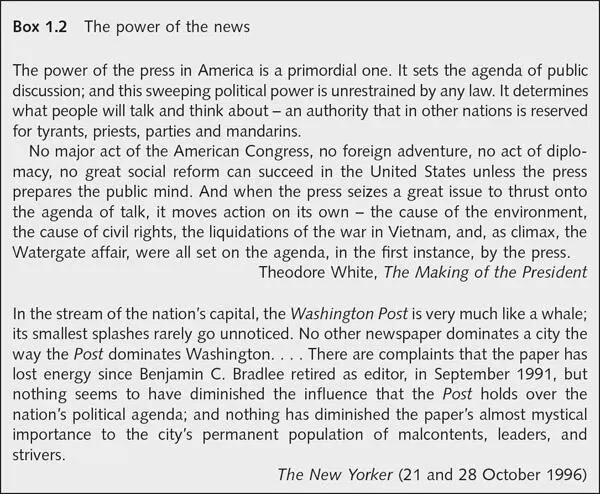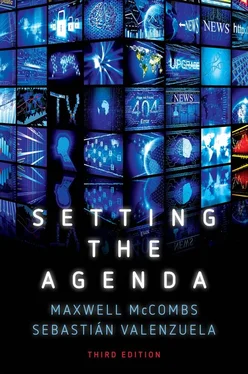
Despite reams of published research, the basic idea of the theory has remained straightforward: Agenda setting refers to the process by which the elements (e.g. issues, public figures, companies, or government institutions) that are deemed relevant by the news media as well as the attributes used to describe these elements often become relevant to public opinion, too. Importantly, the basic agenda-setting hypothesis has been widely documented. The latest meta-analysis – a technique that pools in a statistically meaningful way the results of separate studies – found an average correlation of +0.49 between the media and public agendas. 14To put this number in perspective, consider that the mean effect estimate for human communication phenomena is +0.21. 15This robust collection of evidence also documents the time-order and causal links between the media and public agendas in finer detail. Here is a sampling of that evidence.
The 1972 US presidential election in Charlotte
To extend the evidence for agenda setting beyond the narrow focus on undecided voters in Chapel Hill and their media sources during the autumn 1968 election, a representative sample of all voters in Charlotte, North Carolina, and their news media were examined three times during the summer and autumn of 1972. 16Two distinct phases of election-year agenda setting were identified. During the summer and early autumn, the daily newspaper was the prime mover. With its greater capacity – scores of pages compared to half an hour for network television news – the Charlotte Observer influenced the public agenda during the early months. Television news did not. But in the final month of the campaign, there was little evidence of agenda setting by either the local newspaper or the television networks.
In addition to documenting the agenda-setting influence of the local newspaper on the public, these observations across the summer and autumn of that election campaign eliminated the rival hypothesis that the public agenda influenced the newspaper agenda. When there are observations of the media agenda and the public agenda at two or more points over time, it is possible to compare simultaneously the cross-lag correlations measuring the strength of these two competing causal hypotheses. For example, the influence of the newspaper agenda at time one on the public agenda at time two can be compared with the influence of the public agenda at time one on the newspaper agenda at time two. In Charlotte, the agenda-setting hypothesis prevailed.
The agenda of issues during the 1972 presidential campaign included three very personal concerns – the economy, drugs, and bussing to achieve racial integration of the public schools – and four issues that were more remote – the Watergate scandal, US relations with Russia and China, the environment, and Vietnam. The salience of all seven issues among the public was influenced by the pattern of news coverage in the local newspaper.
The 1976 US presidential election in three communities
An intensive look at an entire presidential election year followed in 1976 and again highlighted variations in the agenda-setting influence of the news media during different seasons of the year. 17To capture these variations, panels of voters were interviewed nine times from February through December in three very different settings: Lebanon, New Hampshire, a small town in the state where the first presidential primary to select the Democrat and Republican candidates for president is held each election year; Indianapolis, Indiana, a typical midsized American city; and Evanston, Illinois, a largely upscale suburb of Chicago. Simultaneously, the election coverage of the three national television networks and the local newspapers in these three sites was content analysed.
In all three communities the agenda-setting influence of both television and newspapers was greatest during the spring primaries, when voters were just beginning to attend to the presidential campaign. A declining trend of media influence on the public agenda during the remainder of the year was particularly clear for the salience of seven relatively remote issues – foreign affairs, government credibility, crime, social problems, environment and energy, government spending and size, and race relations. The salience of more personal matters, such as economic issues, remained high for voters throughout the campaign, regardless of their treatment by newspapers and television. Personal experience can be a more powerful teacher than the news media when issues have a direct impact on people’s lives.
Although these detailed examinations of the issues on the public agenda help us understand the variations in the agenda-setting influence of the news media, the specific issues change from election to election. So it is useful to have a summary statistic that will allow us to compare the degree of agenda setting taking place in different settings. One of the most common measures used by scholars exploring the agenda-setting role of the news media is the correlation statistic. This statistic summarizes precisely the degree of correspondence between the ranking of issues on the media agenda – which issue received the most news coverage, which issue the second most coverage, etc. – and the ranking of those same issues on the public agenda – which issue most members of the public regard as most important, which issue ranks second among the public, etc.
The possible range of scores for the correlation statistic is from +1.0 (perfect correspondence) through 0 (no relationship at all) to −1.0 (a perfectly inverse relationship). Agenda-setting theory predicts a high positive correlation between the media agenda and the subsequent public agenda.
Using this correlation statistic to summarize a key finding from the intensive year-long look at the 1976 presidential election in three different communities, we see that, during the spring primaries when the agenda-setting influence of both television and newspapers was at its peak, the correlation between the national television agenda and the subsequent voter agenda was +0.63. That is a significant degree of influence. In contrast, the correlation between the agendas of the three local newspapers read by these voters and the voters’ agenda of public issues was only +0.34. Nevertheless, this was the peak period for the newspapers. Although it is fashionable to attribute great influence to television in many aspects of life, do not rush to generalize this particular finding about the relative influence of television and newspapers. The final section of this chapter will present a more cautious and comprehensive picture of the agenda-setting role played by various communication media.
These extensive observations of the 1976 presidential campaign across the entire election year provide another opportunity to compare the core hypothesis of agenda-setting theory that the media agenda influences the public agenda with the competing causal hypothesis that the public agenda influences the media agenda. In contrast to the agenda-setting correlation of +0.63 noted above for national television during the spring, over the same time period the correlation between the public agenda and the subsequent national television agenda is only +0.22. The difference between the two is further amplified by comparison with the Rozelle–Campbell baseline, a statistic indicating the value to be expected by chance alone. In this instance the Rozelle–Campbell baseline is +0.37. The agenda-setting correlation is far above this baseline. Its rival is below the baseline. For newspapers, the rather low agenda-setting correlation of +0.34 nevertheless compares quite favourably with the rival correlation of +0.08. The Rozelle–Campbell baseline in this instance also is +0.08. In both of these instances, the evidence corroborates the causal influence of newspaper and television issue agendas on the public agenda.
Читать дальше













